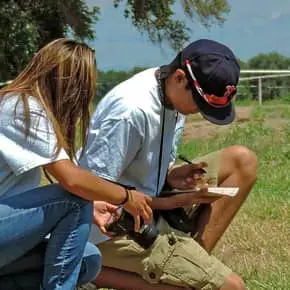
Table of Contents
Introduction
If you are a faculty member who wants to expand your research horizons in collaboration with your students, this article is for you. Given that you are one of the busiest people in the academe, this approach can help you advance your career and instill independent research capacity among students.
I wrote this article for fellow mentors like you so you can reap the rewards of leverage, just like what business owners do. You engage the help of people around you, as you cannot do everything yourself.
Faculty-directed fieldwork, as a source of information for full-blown research, opens new investigation areas or subjects of interest. Student performance in fieldwork also provides you with important insights into managing students for better research pedagogy.
What is Faculty-Directed Fieldwork?
Faculty-directed fieldwork refers to activities performed by the students as part of their learning activities. I will describe how I did this approach to my undergraduate students taking up the research course during the last year of their stay in the university.
As faculty members, we at the university must produce research papers as part of our four-fold functions. Those other three include instruction, extension, and production.
Instruction occupies most of the equivalent 40-hour work-week. The instruction takes up most of the equivalent 40-hour work-week, leaving very little time for the other three, where research is one of the critical functions that need to be fulfilled. The university’s performance as an institution relies on the research outcomes it produces. Research output makes up one determinant of budgetary allocations.
There always is a struggle for the faculty members of a state university, as the time devoted to teaching makes up much of the faculty’s workload. Some faculty members usually end up getting more teaching loads that exceed their equivalent work hour requirements.
But then a dilemma arises where the faculty members must also perform other functions aside from just teaching. One needs to be creative to survive such a situation.
I summarize the benefits of faculty-directed fieldwork to the teachers and students in the following sections.
8 Positive Benefits of Faculty-Directed Fieldwork
Three Benefits of Faculty-Directed Fieldwork to Students
1. Allows Students to Experience Research Firsthand
Faculty-directed fieldwork benefits the students greatly because it allows them to use their research knowledge first hand. They get to communicate with actual respondents in surveys. Experiential learning has been proven as an effective teaching approach as people learn best through experience (Kolb, 2014).
Students get preliminary field data and worthwhile experience during fieldwork to draw useful insights for their thesis proposal later on.
2. Encourages Independent Research
Giving students the freedom to plan and conduct their research tasks instills independence from their teachers’ influence. During fieldwork, the faculty member’s presence sometimes stifles creativity among students as they tend to seek help from their teachers when encountering problem situations. Dealing with challenges in the course of their fieldwork stimulates creative thinking.
3. Develops Favorable Attitude Towards Ecosystem Protection
Field experience develops among students a more positive outlook towards the environment they interact with it in their field surveys. According to Manzanal et al. (1999), fieldwork instills a more favorable attitude towards the ecosystem.
Since attitude is a difficult value to develop among individuals, faculty-directed fieldwork provides greater opportunity for students’ holistic development. A passionate love for nature can emerge that make the experience of students more meaningful.
Five Benefits of Faculty-Directed Fieldwork to Teachers
1. Student Simulated and Actual Research Performance Reveal Areas to Focus Pedagogy
Fieldwork Simulation
In my previous classes, I observed students are not so keen about their research in the field if you let them do things all by themselves. Still, there is a need to guide them with something to direct their attention.
In the tasks I assigned for them as an output of their research course, I developed the survey instruments and trained them on how to administer them in the field. Groups of threes simulated actual fieldwork: one acting as the respondent, one as the interviewer, and the third student, the recorder of the response.
As role-playing progressed, I can spot areas that students need to improve on. For instance, the simple task of introducing themselves and assuring confidentiality in the interviewees’ responses needs strengthening. They must present themselves properly before interviews begin to establish mutual trust in the interview process.
Fieldwork Output
Upon students’ return from fieldwork, I noticed that some of the questionnaire or survey instrument items remained unfilled. Unfilled items become problematic in statistical analysis as the variables in question are omitted.

excellent experience for students.
Hence, a post-fieldwork review allows for troubleshooting of areas that influence the usefulness of the research exercise. The teacher can then institute precautions or reminders to students that they should develop keenness in administering survey instruments.
Another way to rectify this problem is to incorporate redundancy in information gathering. In this sense, redundancy means adding questions similar to another question, thus increasing the chance to capture the required data.
For example, aside from having a blank to fill up the respondent’s age, the interview schedule may include their birth date as a follow-up item. Of course, with the respondent’s consent.
2. Tests Ideas or Hypothesis
Conducting preliminary investigation with students’ help allows you to test your ideas in the field or test the viability of your hypothesis. It serves as a scoping exercise.
For example, you might hypothesize that most of the gleaners who visit the coasts at low tide are women and children. Fieldwork might reveal that this hypothesis is correct only when the seas are calmer. If the weather is inclement, men who usually go fishing may be actively collecting shells along the coast.
3. Identifies Relevant and Practical Variables to Explore
Faculty-directed fieldwork yields unexpected results. Anticipating this possibility, I usually direct my students to list any side comment that may be worth pursuing or help enhance the survey instrument.
For example, in the study of shells gleaned by the fishers’ community, quantification of gleaned shells’ volume requires an initial scoping survey. In one of the fieldwork I supervised, the community members used a tin can to quantify the value of the shells they sell.
Recognizing this detail on measurement, I asked the students to determine the volume of the specific tin can that the local community used in selling the shells. These measures could vary between communities and between individuals. There is a need to standardize this measure.
The identification of a particular shell species gives advanced information on what shells are expected to be gleaned. This knowledge provides an idea of the diversity of species collected thus shed light on the biology of the species. Prior experience of the species further refines the questionnaire.
4. Identifies Potential Problems in the Field
Fieldwork reveals potential issues that can help identify areas for good research design. For instance, preliminary fieldwork will give you an idea of when is the best time to do surveys. Interviewee availability is one of the paramount considerations in field survey designs.
Statistical information, in particular, can help in the design of questionnaires. A well-designed questionnaire minimizes the collection of undesired or unnecessary data. Appropriate measures arise from the information gathered in the preliminary study.
5. Saves Time
Student research-oriented outputs can be useful sources of information for more focused or rigorous study by the faculty. The faculty members’ heavy workloads may prevent them from pilot testing their questionnaire or make preliminary visits to their study sites. Hence, students’ feedback based on their class assignments clarifies and identifies issues regarding data collection.
The pool of data gathered by students can open up areas for further investigation, both for the students and their class instructors. Hence, valuable field data would not be wasted.
I was able to write and present a conference paper using the students’ data using this approach.
References
Kolb, D. A. (2014). Experiential learning: Experience as the source of learning and development. FT press.
Manzanal, R. F., Rodríguez Barreiro, L. M., & Casal Jiménez, M. (1999). Relationship between ecology fieldwork and student attitudes toward environmental protection. Journal of Research in Science Teaching: The Official Journal of the National Association for Research in Science Teaching, 36(4), 431-453.
© P. A. Regoniel 5 December 2020 | Updated 4 January 2024

